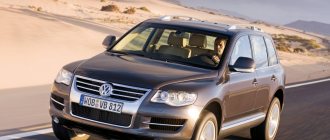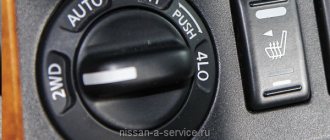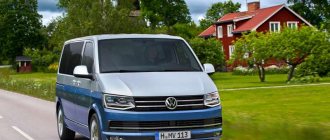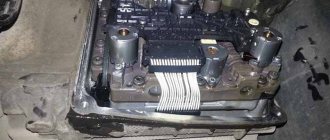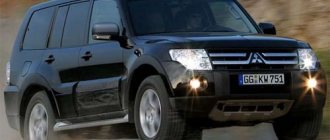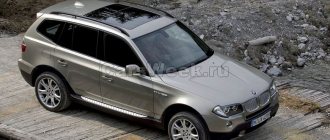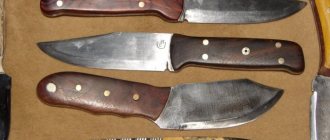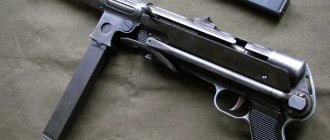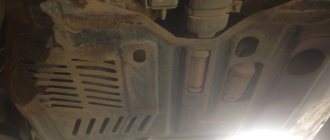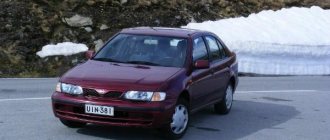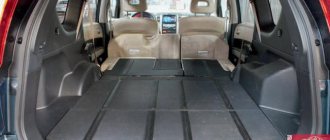Nissan Pathfinder 2008 (3 generations) is a popular crossover in Russia, which is distinguished by its frame design and all-wheel drive. This model stands out from its competitors due to its good maneuverability. The consequence of these factors is that the Nissan Pathfinder r51 has become one of the best-selling crossovers on the secondary market. Moreover, this model appeared in Russia only after its third generation was released. The car was sold in this form from 2004 to 2009, after which it underwent another restyling.
Nissan Pathfinder 2008
Specifications Features
The 2008 Nissan Pathfinder was supplied to the Russian market with three power plants. At the same time, each of the modifications of the Japanese model has earned a lot of positive reviews, which in a certain way affected the prices of a used crossover. In Russia today you can buy a Nissan Pathfinder 3 with the following power units:
- 4-liter 261 hp;
- 2.5-liter diesel with 174 or 190 hp;
- 3-liter diesel with 231 hp.
In Russia, diesel versions of the Nissan Pathfinder R51 were more popular. However, each of these motors is highly reliable. Despite their widespread use, diesel engines in Japanese crossovers do not tolerate low-quality fuel. Because of it, the fuel supply system fails. Some diesel Pathfinder 3 units experience a decrease in traction, which can be eliminated by adjusting the turbine and reflashing the electronic control unit. However, these measures do not always bring results. In this case, you will have to replace the sensor along with the turbine. Moreover, the latter serves about 300 thousand kilometers.
Some versions of Pathfinder require replacement of the diesel particulate filter. This procedure is quite expensive for crossover owners. In this regard, on the Russian secondary market there are often examples of the Japanese model with a diesel engine without a particulate filter. The 2.5-liter turbo unit is prone to overheating. Because of this, cracks appear on its cylinder block. The 3-liter engine is characterized by jamming of the EGR valve. In addition, the intercooler pipes for both engines require replacement every 30-50 thousand kilometers.
A gasoline engine creates more problems for car owners compared to both diesel engines. This is due to the fact that this unit is characterized by gradual destruction of the ceramic catalyst filler, as a result of which solid particles enter the cylinder block, leaving noticeable scratches on them. This defect initially manifests itself in the form of increased engine oil consumption. After 6 years of operation, a Pathfinder with a diesel engine has a fuel level control sensor that fails. This defect seems insignificant if not for the design features of this motor. The fact is that to replace this sensor, you will need to dismantle the fuel pump, which is removed along with the fuel tank. And if a crackling or squeaking noise occurs from the engine compartment, you should contact the generator for a new overrunning clutch.
With a 2.5-liter turbodiesel engine, the 3rd generation Nissan Pathfinder was equipped with only a 6-speed manual transmission. The reliability of this box is not satisfactory, except that the clutch in it can withstand no more than 100 thousand kilometers. With other engines, 5- or 7-speed automatic transmissions are used, which are also famous for their long service life. However, despite the above, when buying a used Nissan Pathfinder r51, you should take into account that the service life of both “automatic machines” does not exceed 250 thousand kilometers. A major overhaul of these boxes will cost a large sum.
One more important nuance must be taken into account: automatic transmissions do not like off-road driving. Because of this, the cooling radiator fails, as a result of which the antifreeze begins to mix with the transmission oil. As a result, the described defect provokes breakdown of the valve body and clutches. When inspecting a Japanese crossover, you should pay attention to the area in the area of the front bumper trim. The cooling system pipe running here often gets chafed. This defect is due to the design features of the car.
As is the case with diesel engines, provided that the maintenance rules are followed, the all-wheel drive system of the Nissan Pathfinder r51 does not create problems. A number of car owners note early wear of the transfer case. This may be due to the fact that the Japanese model was regularly operated on smooth asphalt with all-wheel drive engaged. Over time, the cardan shaft crosspieces and transfer case seals wear out. The remaining parts of the design last much longer.
Characteristics of Nissan Pathfinder / Nissan Pathfinder
The Pathfinder model is well known to many under the name Terrano. The first generation came out in 1986. This car received the name Pathfinder on the American market, by the way, and it was also produced in the USA. The American version had its own characteristics and differences from the regular Terrano. For example, the Nissan Pathfinder had a softer suspension, mainly an automatic transmission and rear disc brakes. The interior, as a rule, was more richly equipped than that of the Terrano.
At first, the Pathfinder was produced in a three-door version; 5-door cars appeared only in 1989. Most often, the Pathfinder had a simple velor interior, although it was possible to find options with expensive leather trim. It was capable of accommodating about five people.
The main driving force of the Nissan Pathfinder was a 3-liter V6 engine producing 147 hp. The basis of the design was a powerful spar frame, the front suspension of the car was double wishbone, torsion bar, and a one-piece beam was used in the spring suspension of the rear wheels. Also included in the serial kit of the car were a two-speed transfer case and a rear differential lock necessary for off-road assault.
Production of the Nissan Pathfinder continued until 1996, after which a new second-generation car was shown in the USA and Japan. In 1997 and 1999, the car underwent upgrades. The Nissan Pathfinder, which was born in 1999, has caused some criticism from automotive experts. The target of attack was the engine, which was too weak for this class of car. A fundamentally new solution for the car's transmission went virtually unnoticed, which, on the one hand, ensured with its rigidity ease of control and maneuvering, and on the other hand, reduced the noise level of the transmission when the car was moving.
As you would expect, the new model has undergone modernization. And already in 2001, under the hood of the Pathfinder, a new V6 engine with 24 valves made of aluminum appeared, which became more powerful and more economical than its predecessor. The engine displacement was 3.5 liters, it was capable of developing power in the range of 220 - 240 hp. Paired with the engine, two transmission options are used: a 5-speed manual transmission and a 4-speed automatic transmission.
The gas distribution system has become more complex and has dynamic control. The engine was also equipped with several complex electronic systems: SOFIS (sophisticated fuel injection optimization system), ECCS (continuous control system), OBDII (on-board diagnostic system), NCVCS (intake valve timing control system), NDIS (direct ignition system), NVIS (variable intake system), etc.
The optics also changed: they installed parabolic headlights covered with impact-resistant glass. Many electrical devices have appeared to make the driver’s life easier: heated door locks, a sensor for automatically turning on headlights depending on the lighting, a Vehicle Security System (VSS) alarm controlled from a key fob. Air conditioning with climate control, heated rear passenger seat and, of course, full power accessories (windows, mirrors, sunroof, seats).
The second generation Nissan Pathfinder is a car that combines cross-country ability and comfort.
In 2004, at the Detroit auto show, Nissan introduced a new, third generation of the Nissan Pathfinder SUV. This new product is built on a new platform, has a different body design, interior trim and has a modern V6 engine.
The third generation has become noticeably larger, which made it possible to place three rows of seats in the cabin, while ensuring high comfort for all passengers. Thanks to the wide possibilities for transforming the interior, there are 64 options for different interior layouts!
Nissan Pathfinder also boasts independent suspension on all wheels and a new all-wheel drive system with several operating modes. We also note that the all-wheel drive system is integrated with other vehicle systems to enhance the vehicle's off-road capabilities. In particular, the new product received a throttle control system, which prevents its sudden opening in the event of poor tire adhesion to the road, as well as a directional stability system adapted for operation in off-road conditions.
The third generation Nissan Pathfinder can be equipped with two powertrain options: a 2.5-liter turbodiesel with a capacity of 174 hp, as well as a 4-liter gasoline engine with a power of 269 hp. Paired with a diesel engine, both a manual and automatic gearbox can be used, while the gasoline version is equipped only with an automatic transmission. Both engines provide decent dynamics when driving on the highway (acceleration from 0 to 100 km/h is 9 s and 12 s, respectively, for petrol and diesel versions) and are not too power-hungry.
Safety on the road is ensured by disc brakes, an EBD brake force distribution system, and a brake-assist emergency braking system. Passive safety will be provided by two front airbags.
The car received a new supporting frame made of steel profiles. Short body overhangs should allow it to cope better off-road. Separately opening rear door glass makes loading luggage easier.
The main principles on which the third generation of Pathfinder was created were more capacity and more cross-country ability. The new product will be produced at one of the company’s factories in the USA.
In 2010, company specialists restyled the model. There are minimal changes in the appearance of the car. Only an experienced eye will discern the external differences between the old and modernized Pathfinder. The front bumper has become rounder, and the rear, on the contrary, has become more angular. The massive, shiny three-section radiator grille, shaped like the letter “V,” looks a little heavier. The overall impression that appears when looking at the 2010 Pathfinder is that of a solid, trim and not without aggressive SUV. What makes it so is the sharp, as if carved from stone, body features; boldly prominent arches hanging over wide wheels; powerful roof pillars, large glass area, large side steps.
Changes also affected the interior, where it became much more comfortable. We replaced materials where we could with more expensive ones in appearance and touch, built in an illuminated instrument panel on top versions, and for them a new audio-navigation complex with DVD and a 40-gigabyte hard drive was included in the list. There is a lot of space inside. Neither the driver, nor the front passenger, nor the passengers of the two rear rows will feel cramped.
All passenger seats can be individually folded completely or partially, while fully folded seats form a flat surface without any ledges or transitions. The total number of options for transforming the interior is 64. The interior can easily transport objects up to 2.8 m in length. The trunk volume with the rear seats up is only 190 liters. If you remove them, you get 515 liters.
The main change is hidden under the hood. The 2.5-liter diesel engine became turbocharged and “matured” by 16 hp. and 47 Nm. Now the power is 190 hp. at 4000 rpm. Maximum speed 186 km/h. The engine is equipped, depending on the configuration, with a 6-speed manual or 5-speed automatic transmission. It accelerates more smoothly and emits fewer harmful substances into the atmosphere. The declared fuel consumption in mixed mode is 9-12 liters per 100 km (from 8-10 liters on the highway, from 11-13.5 liters in the city, depending on the gearbox).
A gasoline engine is also offered - a 3.0-liter V6 with 231 hp. This power unit is offered only in tandem with a 7-speed automatic transmission. In this configuration, the SUV is capable of reaching a maximum speed of up to 200 km/h, and reaches the first hundred in 8.9 seconds. Fuel consumption in “mixed” driving mode is ~ 10 liters per 100 km.
All trim levels are equipped with front and rear disc brakes with ABS, independent rear and front suspension, and 17-inch alloy wheels.
This entire electronically controlled set allows the driver to feel confident when driving on sand, driving over rough terrain and deep puddles, and when overcoming snowdrifts. Overall cross-country ability is not bad: departure angle is 26 degrees, approach angle is 33 degrees.
Of course, all these changes and improvements were designed to extend the production life of Pathfinder III.
At the 2012 Detroit Auto Show, the Japanese showed the concept of the new fourth-generation Nissan Pathfinder, and in early August the automaker officially presented the production version of its SUV, which, unlike the previous version, received a monocoque body instead of a frame structure. We can safely say that the car has been seriously modified both outside and inside.
The fourth generation is based on the modular FF-L platform, on which the Infiniti JX and Nissan Murano crossovers, as well as the Maxima and Altima sedans, are built. Overall dimensions of the body are: 5009 mm in length, 1960 mm in width, 1768 mm in height, 2900 mm wheelbase, 190 mm ground clearance.
Externally, the fourth generation began to look more streamlined, having lost its rough chopped shapes, but still largely repeats the silhouette of its predecessor. The rear and front spoilers, as well as suspension fairings and rear tire deflectors give the car body special dynamics. Thanks to their use, the car looks faster and more aggressive. In addition, these body design elements significantly improve the aerodynamic resistance of the car. The front of the car is distinguished by slanting headlights, an inverted trapezoidal false radiator grille, framed by a wide chrome frame. Other new design features include chrome door handles and enlarged rear lights.
The interior of the seven-seater 2013 Nissan Pathfinder has improved finishing materials, including genuine leather, and promises ample legroom for passengers in the second and third rows of seats. As for the interior design, it is radically different from its predecessors. The dashboard is equipped with a 4-inch color monitor of the on-board computer, as well as an additional touch display that provides communication between the driver and the main vehicle systems.
The abandonment of the frame structure, according to the automaker, has made it possible to increase the number of options for transforming the interior, as well as to achieve a flat floor when the rear row seats are folded. Thanks to the second-row EZ Flex Seating System, entry into the third row is comfortable and easy. The second row with separate seats can move along the cabin by 14 cm.
The trunk is able to accommodate 453 liters with seven crew members; by folding the third row, we can load 1200 liters of cargo; when transforming the third and second rows, a cargo area with a volume of 2260 liters is formed.
The Nissan Pathfinder 4 will be equipped with three-zone climate control, a multimedia system with a DVD player and monitors for rear passengers, a Bose audio system with 13 speakers, an electric tailgate, a surround video system, a heated steering wheel, as well as ventilated front seats and heated seats. second row.
Under the hood of the 2013 Nissan Pathfinder is a 3.5-liter V6 gasoline engine with a power of 265 hp, which is paired with the latest generation Xtronic CVT continuously variable transmission. There are all-wheel drive and front-wheel drive versions. According to the manufacturer, the average fuel consumption of the SUV, compared to its predecessor, was reduced by 25%.
Such a significant improvement in fuel efficiency was achieved thanks to the abandonment of the frame structure. This also made it possible to reduce the weight of the car by 227 kg. The front-wheel drive SUV weighs 1,882 kg, while the all-wheel drive SUV weighs 1,946 kg. The 2013 Pathfinder has a lighter body and powertrain. It was also possible to reduce the weight of the car by installing a new continuously variable transmission.
The suspension is completely independent, MacPherson struts at the front, multi-link at the rear, and anti-roll bars are used. Steering with electric power steering capable of changing characteristics, disc brakes with electronic assistants and assistants in the form of ABS with EBD, Hill Start Assist, Brake Assist Vehicle, Dynamic Control (VDC) with traction system (TCS), Active Brake Limited Slip (ABLS).
Features of the body and interior
The quality of the paintwork on the Nissan Pathfinder 2008 leaves much to be desired. But this does not mean that the car body becomes covered with scratches after almost every trip, and its parts begin to quickly rust. However, about a year after the release of the crossover, the paint swells in various places. At the same time, the Japanese model has a high-quality anti-corrosion coating that reliably protects the car from rust. The latter is mainly localized on the wheel arches and hood, as well as near the windshield.
The Nissan Pathfinder lacks quality finishing. The plastic with which the interior of the crossover is abundantly lined begins to creak and make other unpleasant sounds over time. The seat trim is also peeling. Owners of the Japanese model note the appearance of moisture on the roof, which is associated with wear of the sealing gaskets. When buying a car, you should check the functionality of the buttons on the steering wheel, as its cable often breaks. The same applies to the pipes of the air conditioning system, which lie under the bottom and because of this often rust. The rest of the onboard equipment breaks down less often.
European car classification
Cars are very complex units, so they cannot be classified based on just one criterion. But the most popular type of classification today is the European classification.
- Class "A". This class includes small cars, which usually have three doors. In some cases, five-door cars are also included in this class, but with the condition that they are compact, economical and maneuverable cars.
- Class "B". Cars in this group are slightly larger than the previous class. Although the level of comfort is higher, it is far from luxury.
- Class "C". Cars of this class are quite powerful and durable, perfect for short distance travel and daily trips. Cars allow you to transport 5 people, including the driver.
- Class "D". Here the cars have an interesting design, a comfortable interior and a spacious trunk.
- Class "E". Cars of this class belong to the business class. A spacious trunk, a comfortable and spacious interior, and independent suspension are not all the advantages that cars of this class have. In such cars you can travel long distances and still feel comfortable.
- Class "F" are luxury cars. There is a maximum level of comfort, the best interior trim, excellent driving dynamics and maximum speed.
- Class "S". This includes convertibles and roadsters. As a rule, they have two seats, but there are models that have four seats. These are sports cars with a rigid suspension, high speed and low seating position.
- Class "M". This class includes convertibles that have up to nine seats. The difference between this class is its roomy interior and not pronounced hood.
- Class "J". A fairly popular class of cars among Russian consumers, which includes SUVs, SUVs and crossovers. They have high ground clearance, durable suspension and high cross-country ability.
- Pickups. These cars have a special design; here the passenger compartment is separated from the luggage compartment. Cars are used to transport small loads.
The page shows the dimensions of the Nissan Pathfinder (Nissan Pathfinder dimensions: length, width, height).
Repair costs
In fact, if we exclude situations where the service life of motors and gearboxes has come to an end, the cost of servicing a Japanese crossover will be relatively low. Only the clutch of a manual transmission, which requires replacement every 100 thousand kilometers, costs about 35 thousand rubles. But you need to take into account that consumable components for the 2008 Nissan Pathfinder are estimated at a fairly large amount. Although this drawback is offset by their reliability. In particular, suspension parts need to be changed relatively rarely:
- stabilizer struts and bushings (every 40 thousand kilometers);
- ball joints (80 thousand kilometers);
- shock absorbers, wheel bearings (120 thousand kilometers);
- silent blocks (150 thousand kilometers).
The Pathfinder's steering controls leave no one to agree on. For some motorists they break down before a mileage of 50 thousand kilometers, for others they last 2 times longer. But the braking system stands out for its high reliability. So, pads need to be changed every 40 thousand kilometers, discs - 100 thousand.
Options and prices (summary table)
| # | Equipment | Model years | Drive unit | Transmission | Engine, cc. cm | Acceleration from 0 to 100, s | Max. speed, km/h | Power, max., hp (kW) at rpm | Fuel consumption in the combined cycle, l/100 km |
| 1 | 2.5 Cdi MT LE | 2005 — 2009 | Full (4WD) | Manual transmission 6 | 2488 | 11.5 | 175 | 174 (128) / 4000 | 9,0 |
| 2 | 2.5 Cdi MT LE+ | 2005 — 2009 | Full (4WD) | Manual transmission 6 | 2488 | 11.5 | 175 | 174 (128) / 4000 | 9,0 |
| 3 | 2.5 Cdi MT SE | 2005 — 2009 | Full (4WD) | Manual transmission 6 | 2488 | 11.5 | 175 | 174 (128) / 4000 | 9,0 |
| 4 | 2.5 Cdi MT SE+ | 2005 — 2009 | Full (4WD) | Manual transmission 6 | 2488 | 11.5 | 175 | 174 (128) / 4000 | 9,0 |
| 5 | 2.5 Cdi MT XE | 2005 — 2009 | Full (4WD) | Manual transmission 6 | 2488 | 11.5 | 175 | 174 (128) / 4000 | 9,0 |
| 6 | 2.5 Cdi AT LE | 2005 — 2009 | Full (4WD) | Automatic transmission 5 | 2488 | 11.6 | 174 | 174 (128) / 4000 | 10,1 |
| 7 | 2.5 Cdi AT LE+ | 2005 — 2009 | Full (4WD) | Automatic transmission 5 | 2488 | 11.6 | 174 | 174 (128) / 4000 | 10,1 |
| 8 | 2.5 Cdi AT SE | 2005 — 2009 | Full (4WD) | Automatic transmission 5 | 2488 | 11.6 | 174 | 174 (128) / 4000 | 10,1 |
| 9 | 2.5 Cdi AT SE+ | 2005 — 2009 | Full (4WD) | Automatic transmission 5 | 2488 | 11.6 | 174 | 174 (128) / 4000 | 10,1 |
| 10 | 4.0 ATLE | 2005 — 2009 | Full (4WD) | Automatic transmission 5 | 3954 | 8.9 | 190 | 269 (198) / 5600 | 13,5 |
| 11 | 4.0 AT LE+ | 2005 — 2009 | Full (4WD) | Automatic transmission 5 | 3954 | 8.9 | 190 | 269 (198) / 5600 | 13,5 |
Alternative choice
You can compare the 3rd generation Nissan Pathfinder with the following models:
- Mitsubishi Outlander;
- SsangYong Rexton;
- Honda Pilot
- Subaru Forester.
The Mitsubishi Outlander is in no way inferior to the Pathfinder in terms of the reliability of the installed engines. However, the first model more often has problems with the suspension, its variator does not stand up to criticism, and all-wheel drive is intended only to increase stability on slippery roads. But Outlander costs about 200 thousand rubles less than its competitor.
SsangYong Rexton is the only one of the presented models (with the exception of Pathfinder) with a frame structure. Another positive feature of the Korean model is its high-quality all-wheel drive. Rexton owners also note the engines’ unpretentiousness to fuel. But in terms of durability, the Korean crossover is slightly inferior to its competitor. However, this is offset by the fact that the Rexton will cost 100 thousand rubles less than the Pathfinder.
The Honda Pilot is more focused on urban environments, where it outperforms its rival. This model, according to car enthusiasts, is better in terms of engine and gearbox characteristics, suspension reliability and other parameters. But, as is the case with many other Japanese crossovers, servicing the Honda Pilot costs a large amount of money.
Subaru Forester is also designed for off-road driving. Under these conditions, the Japanese model fully reveals itself. At the same time, the car does not have a frame structure, its all-wheel drive does not tolerate constant slipping, and the cost of maintenance is quite high.
